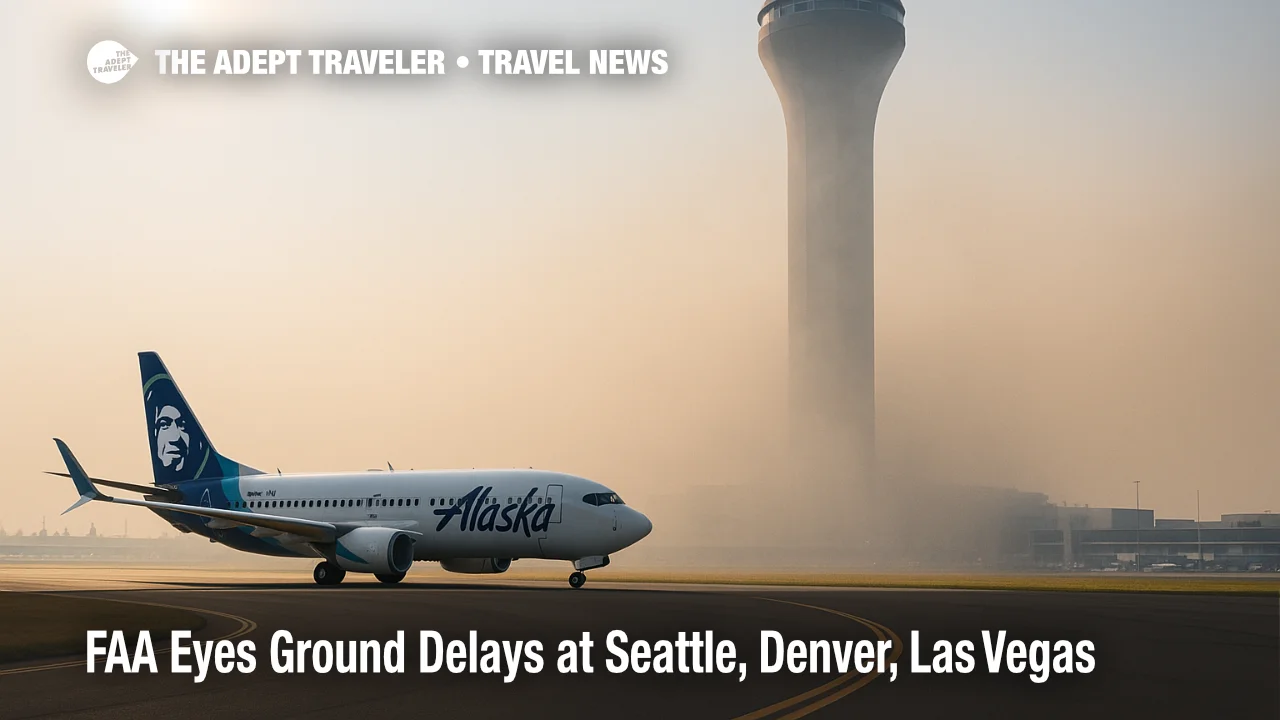FAA Eyes Ground Delays at Seattle, Denver, Las Vegas

The Federal Aviation Administration's afternoon Operations Plan warns that worsening thunderstorms, low ceilings, and drifting wildfire smoke could trigger ground-delay programs or even ground stops later today at Seattle-Tacoma International Airport (SEA), Denver International Airport (DEN), and Harry Reid International Airport (LAS). The agency is already slowing arrivals on select routes, and airlines are encouraging travelers to monitor flight status and consider early rebooking. The alert comes as peak summer traffic coincides with an active wildfire season across the West.
Key Points
- Why it matters: Three busy hubs could see cascading delays nationwide.
- Travel impact: Airlines may impose flexible rebooking and waive change fees.
- What's next: FAA will decide after the 1915Z planning webinar if full programs are needed.
- Extra risk: Convective storms may force sudden ground stops.
- Air-quality concern: Dense smoke is reducing visibility in Seattle and Denver.
Snapshot
The 6 p.m. UTC Air Traffic Control System Command Center bulletin lists LAS under high-wind constraints and groups SEA with SFO, LAX, and SAN for low ceilings. DEN joins the watch list because smoke from regional wildfires has lowered surface visibility below five miles at times. A similar advisory on Tuesday slowed flights into Denver and briefly curtailed arrivals at Las Vegas. Passengers should keep mobile notifications on and check the real-time FAA Daily Air Traffic Report (https://www.faa.gov/newsroom/faa-daily-air-traffic-report?utm_source=adept.travel).
Background
Ground-delay programs (GDPs) meter traffic into an airport when weather or runway limits cut capacity. Airlines receive controlled departure windows, preventing crowded holding patterns and conserving fuel. GDPs differ from ground stops, which halt departures entirely. Low clouds and smoke frequently trigger GDPs at Pacific Northwest airports in late summer, while convective cells over the Rockies often disrupt Denver. According to ABC News, the FAA slowed arrivals at DEN on August 5 because of smoke haze, and similar conditions persist today. Harry Reid International, surrounded by desert terrain, is sensitive to gust fronts and wind shear.
Latest Developments
Smoke dims Denver visibility
Colorado's Department of Public Health has an Air Quality Health Advisory through Friday morning as particle concentrations climb. The FAA Ops Plan notes that reduced surface visibility could require a GDP for DEN if 2-mile visibility thresholds are breached. Should a program be issued, average arrival delays of 45 to 90 minutes are likely. The advisory mirrors Tuesday's slowdown reported by ABC News (https://abcnews.go.com/US/air-quality-alerts-place-10-states-wildfires-burn/story?id=124371722&utm_source=adept.travel).
Thunderstorms threaten Las Vegas arrival rates
The Storm Prediction Center highlights isolated severe cells along the Mojave edge this afternoon. Gusts above 35 knots have already prompted traffic-management initiatives at LAS, and the Ops Plan labels high winds a terminal constraint. Airlines may pre-emptively reroute or delay departures to avoid gate congestion during any ground stop.
Low ceilings and marine layer at Seattle
An onshore push of marine air dropped ceilings below 1,000 feet at SEA before noon. The Ops Plan groups Seattle with other West Coast airports for possible GDPs if recovery stalls. Alaska Airlines, the field's largest carrier, has advised passengers to arrive early and use electronic boarding passes to ease security lines.
Analysis
Summer afternoons challenge the National Airspace System because convective heating, monsoon moisture, and wildfire smoke often converge. When three geographically distant hubs face simultaneous constraints, delay propagation accelerates. A ground-delay program at SEA reduces trans-Pacific departure slots, which can push wide-body aircraft into later traffic banks at DEN and LAS. Smoke adds complexity because visibility can drop unpredictably, forcing dynamic adjustments to arrival rates. Carriers operating hub-and-spoke models must juggle crew duty limits and aircraft rotations; travelers may encounter rolling delays even if a formal GDP is never issued. For first-time flyers, the takeaway is simple: build buffer time, keep itineraries flexible, and purchase travel insurance that covers missed connections. The FAA's real-time dashboards and airline apps remain the fastest way to verify gate assignments and delay codes.
Final Thoughts
Whether or not the FAA authorizes full ground-delay programs, the afternoon watch list signals elevated disruption risk. Travelers bound for Seattle, Denver, or Las Vegas today should anticipate schedule changes and pack patience. Monitoring alerts and acting quickly on rebooking offers is the best hedge against long waits brought on by a sudden ground delay program.
